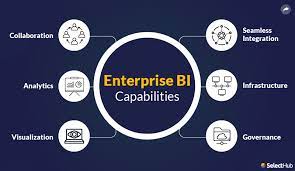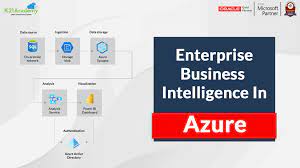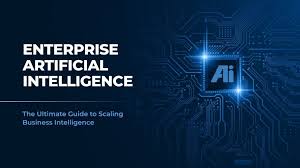In 2020, 54%[1] of enterprises agreed that cloud-based business intelligence was vital to their current and future initiatives. Primarily, that’s because this discipline is extremely helpful when it comes to the decision-making process, data analytics, and research and development. No matter whether we talk about SMEs or large enterprises, enterpise business intelligence is a tool that will only gain importance over the years.
In this article, we are going to take a closer look at enterprise business intelligence–a solution for the largest, most demanding companies. We will focus on the main elements and capabilities of enterprise business intelligence.
Prominent worldwide corporations harness business intelligence algorithms and applications in order to:
- Conduct various studies and adjustments
- Improve the decision-making process
- Obtain valuable insight concerning data they process
- Find new ways of development
Also, this enterprise business intelligence is frequently used to monitor business and optimize the usage of available resources, primarily those relating to information. However, according to diverse sources, enterprise business intelligence makes a case for itself, especially when thinking about improving decision-making. That’s because data analytics makes decision-making 5x faster for businesses. The benefits are obvious.
That’s why today, enterprise business intelligence services are more and more extensively used, both by large international organizations but also by small and medium-sized companies.

What is enterprise business intelligence?
We could shortly say that enterprise BI revolves around the deployment of BI in a large corporation. Actually, there are no significant differences between enterprise BI and normal BI. Different terminology was necessary, though, because larger and more complex organizations produce far more data than SMEs and require more extensive and complex BI software solutions.
Now, why do large companies require enterprise BI platforms and tools? Primarily because these tools offer higher capacity for data management and analytics. Typically, they also provide more features and extensions, which may come in handy in a large international environment. We will talk about enterprise business intelligence platforms in a few moments.
Benefits of enterprise business intelligence
Thanks to enterprise BI, large corporations have access to many valuable benefits that significantly impact the way a given organization works. Enterprise business intelligence enables:
- Identifying and pinpointing potential business issues that need to be addressed or solved
- The quicker and more informed decision-making process
- Increased operational efficiency and general productivity
- Improved marketing and sales strategies
- Enhanced HR and employment
Elements of enterprise business intelligence
Generally speaking, business intelligence is a discipline that combines several elements that, when put together, provide your company with the information you need to grow business and make accurate decisions. These elements are as follows:
- Data cleaning
- Reporting and exploration
- Dashboards
- Predictive analytics
Let’s analyze each of these elements shortly.
Data cleaning
Not all data large enterprises process is of high quality. This is where data cleaning becomes indispensable. Thanks to so-called data quality tools, you can easily remove formatting errors, typos, redundancies, and other issues that adversely affect the quality of your data.
As a result, your data sources are more useful, and BI programs can do their job more effectively.
Reporting and exploration
Reporting is the process of organizing data in a readable form that allows for quick drawing of conclusions, usually with the intention of monitoring business performance. It’s a resultant of the exploration process where you analyze and explore data your company processes. The reporting features are used to understand how fast your company grows and pinpoint potential areas of improvement. The results and insights drawn from the exploration and reporting stages can be depicted with the usage of a dashboard.
Dashboards
Dashboards are the best way to make the most of data visualization. With a decent dashboard, you have a quick and easy view of multiple metrics within your company and its customers. You can think of a dashboard as a smarter Excel sheet. These data visualization tools gather all the data you process and present it to you in an easy to understand way. In effect, interpretation is effortless.
In many ways, the dashboard enables you to make more accurate decisions, predict the scale of your growth, and indicate weak points that need to be addressed immediately because they showcase everything you need to know in an intuitive and straightforward form.
Make sure the dashboard you get with the BI platform comprises all the data visualization features you might need in the future, including maps, charts, infographics, heat maps, and other visualization methods.
Predictive analytics
Who wouldn’t like to know what the future holds? Enterprises do, too, therefore something called predictive analytics simply had to emerge. In today’s business environment, predictive analytics plays a crucial role. It helps companies make more informed decisions and analyze potential scenarios. In large enterprises, predictive models provide managers and CEOs with a range of possible outcomes and their potential consequences to the company.
Capabilities of enterprise business intelligence platforms
As we mentioned earlier, large corporations require more advanced solutions and extended capabilities. They comprise i.a.:

Colloboration
Large enterprises use business intelligence software to support the operation of at least several different departments. This means that there’s more than one user that needs to have access to the BI platform. Enterprise BI programs offer the possibility to collaborate with other users and departments and publish, distribute, and share insights. In some cases, even with outside entities. Of course, at this point, cybersecurity features are also critical.
Advanced analytics
Advanced analytics is one of the most complex and multidimensional areas in the data science field. It comprises strictly strategical, analytical, and consulting competencies:
- Strategy analytics
- Predictive analytics
- Statistical analysis
- Analytical support
- Machine learning algorithms
Self-service infrastucture
In general, it’s better to look for a BI platform that’s self-service, i.e. and doesn’t require the whole IT team to manage and maintain it. However, you have to acknowledge that it’s not always possible when it comes to enterprise-level BI platforms. Some of them are managed centrally by an IT department. This approach is especially common concerning enterprise BI tools that are deployed on-premises.
Large enterprises also pay attention to customizable dashboards, extended reporting capabilities, organization tools, and advanced search functions. The goal is simple–to get the necessary insight as quickly as possible.
Integration
It is always vital to look for a tool that can be easily integrated with your current IT infrastructure, both on-premises and in the cloud. All the users ought to have the possibility to access the platform from any device or operating system.
Data sources
Here’s another element you have to think about. In large organizations, data sources differ from those in small companies. The enterprise business intelligence platform of your choice has to have the ability to process all these diverse data sources. When it comes to small businesses, we talk about a few hundred data sources tops. The majority of them can be presented in a CSV file.
However, we usually talk about data warehouses that store all the information organized by variegated formats on the enterprise level. The BI platform you work with ought to read and process these formats seamlessly and correctly.
Data governance
Standard enterprise business intelligence platforms don’t always have data governance capabilities which are crucial in the enterprise environment. Shortly put, data governance comprises policies, procedures, protocols, and metrics that are used to control how data in your company is used and managed. It’s big data governance tools that help you use big data you process effectively and responsibly.
Moreover, thanks to data governance, enterprises can take care of their data integrity and security.
Enterprise business intelligence tools and platforms
Of course, there are many enterpise business intelligence tools and platforms available that offer enterprise-level functionality. Actually, you have quite a broad choice that comprises the following platforms:
Cloudera
Cloudera’s BI platform lets you put shared data at the center of your architecture, bringing multiple applications and frameworks together to extend the value of your data and operationalize your analytics as part of your real-time applications. They also provide a community of Hadoop developers and experts to help businesses make full use of the open-source potential.
Oracle BI
Oracle is one of the largest software developers in the world. Their Oracle Business Intelligence solution comprises a set of technology and applications that provide the industry’s first integrated, end-to-end Enterprise Performance Management System, including BI foundation and additional tools allowing for reporting, analysis, alerting, mobile analytics, data integration, and management as well as desktop integration.
What’s especially important, Oracle BI can process ad hoc analysis for quick decision making.
SAP Business objects business intelligence
It’s a centralized suite for data reporting, visualization, and sharing. Inside, you will find several useful dynamic features, such as ad hoc reporting, predictive analytics, enterprise business intelligence dashboards, and even mobile applications.
Of course, SAP’s BI solution can be easily integrated with SAP’s other analytics platforms making the whole thing much more effective and versatile, creating one comprehensive analytics solution for large companies.
Microstrategy
They call themselves the #1 modern, open enterprise platform. It’s one of the easier BI solutions. MicroStrategy’s platform consists of drag-and-drop functions and comes with desktop and mobile versions. Additionally, it offers intuitive visuals and one-click sharing for the insights you obtain thanks to this platform. With MicroStrategy, you have access to:
- Self-Service Dashboards
- Data visualization tools
- Location-based Analytics
- Highly-formatted Reporting
- All Enterprise Data Assets
- Sophisticated Analysis
MicroStrategy also offers something called hyper analytics, a solution that allows you to make smarter and faster decisions by injecting insights into every application, including your websites and MS Office.
Siesense Fusions
Sisense Fusion is an AI-fueled embedded analytics platform that infuses intelligence into your workflows, processes, and applications to enhance the customer experience and transform your business into something better and more effective. Sisense developers wanted to build a solution focused on delivering quick results, offering intuitive reporting and transparent data visualization features. Of course, with Sisense Fusion, you can integrate and combine data from diverse sources and datasets.
DOMO
DOMO offers a cloud-based BI platform designed to provide simplified, real-time access to business data and insights with minimal IT involvement. This solution is worth mentioning primarily because it’s available only in the cloud. This means DOMO is 100% mobile-friendly and can work in real time.
So far, we have analyzed what enterprise BI is all about, how this solution can be used, and what benefits it entails. Now, it’s time to think about the ways to implement a strategy or program that will allow you to make the most of enterprise business intelligence.

Devise a BI strategy
In general, if you want to implement business intelligence in your enterprise, you have to follow a process that comprises 7 elements. Here they are:
Get management approval: In large corporations, everything has to be approved and included in the budget. Therefore that’s your starting point. Without necessary approvals and funding, you won’t be able to go any further.
7 elements of business intelligence implementation
- Start with a general idea: The way to optimal BI strategy starts with thinking of the big picture. What do you need BI for? What goals should this solution help you achieve? Also, at this point, it is vital to conduct an audit of current data analytics tools in your company. Ask people working with them about the challenges and problems they encounter in everyday work. This will give you a priceless insight into where to go next.
- Create a BI team: Build a team responsible for implementing and managing future BI solutions. BI teams typically consist of BI architects, developers, and analysts. This part is especially critical in the enterprise setup because enterprise BI platforms frequently require advanced IT competencies.
- Design the BI architecture: You have to think of your future platform’s hardware and software elements. Additionally, you need to design data flows (from source systems to data warehouses and BI platforms). At this point, you also have to decide whether your BI platform will be cloud-based or on-premises. Both solutions have their pros and cons, and the decision depends on your particular situation and needs.
- Select the best BI software: In this article, we showed you six options to choose from. Of course, you can look for other enterprise business intelligence platforms. Just make sure they offer all the functions and features you need. Pay extra attention to data visualization and reporting features because, at the end of the day, that’s where the good BI platform stands out of the competition.
- User training: Once you’ve done all that, you have to train future BI platform users. Make sure everyone who will have access to that platform knows: How to operate it? What can be done with it? What are crucial privacy and safety regulations and procedures?
- Deploy and start working with the selected BI platform: You’re almost good to go! Everything is set and ready to work. However, before you go online with your new BI platform, do some tests, make sure everything works as planned and there are no glitches or integration problems.
To sum up
To sum up, enterprise business intelligence can be a true milestone in your company’s development. However, before you start using this advanced IT solution, you have to prepare and make sure there are no obstacles that could block your work or deteriorate the results. Follow our seven-step process to make sure you avoid this scenario.
And if you need help with enterprise business intelligence–the Addepto team is at your service. We are an AI consulting agency that specializes in enterprise business intelligence. We will help you prepare your IT infrastructure and devise an efficient strategy that will allow you to make the most of this fascinating tool. Drop us a line for details.
